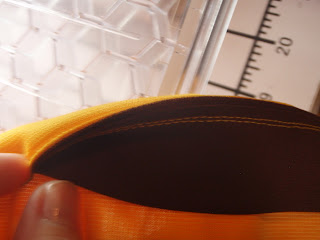
 On February 18th, Colette Patterns had a book signing party and trunk show at Sew LA. You could receive 20% off all Colette patterns but if you wore one of her designs, you could get 30% off! Now I had been planning on making a Peony for some time and had some fabric set aside for it...and guess what? The fabric was red! So not only was it perfect for me to make for the event, I can also enter it into the Red Dress contest on pattern review and use it for the Sew Weekly theme from last week---red. (You can see my entry here. I am not a contributor because I did not know at the time, but I did apply....it said they were still accepting people...but I have not heard anything yet.)
On February 18th, Colette Patterns had a book signing party and trunk show at Sew LA. You could receive 20% off all Colette patterns but if you wore one of her designs, you could get 30% off! Now I had been planning on making a Peony for some time and had some fabric set aside for it...and guess what? The fabric was red! So not only was it perfect for me to make for the event, I can also enter it into the Red Dress contest on pattern review and use it for the Sew Weekly theme from last week---red. (You can see my entry here. I am not a contributor because I did not know at the time, but I did apply....it said they were still accepting people...but I have not heard anything yet.) |
| Fabric detail close up---those are not wrinkles! Those are the striped gradation in the fabric |
For this pattern, I did make a muslin of the bodice because I know Colette patterns are designed for bustier gals than I. Of course I somehow convinced myself the muslin fit...no idea what I was thinking...and went and sewed it than way. Of course it did not fit! So I made up some changes that resulted in an SBA but it is not the correct way to do it if you do it before you make up your garment. I went to the waist dart and moved the dart legs each in a half inch on each side...so the darts were each 1 inch shallower...and i continued the line up to the same point as before. Seemed to work...because the bodice fits perfectly now. I also altered the bodice to be 1/4 inch longer...or I intended to anyway. I did the front bodice correctly while I was tracing off the pattern...and while I was not thinking, I traced the back bodice off 1/4 inch shorter---I moved the paper the wrong way! So the front and back bodice were 1/2 different from each other. I just eased the back 1/4 inch and cut off the other 1/4 inch so the bodice ended up being the exact same size as the original pattern!
Another change I made was to add piping to the sleeves and the belt....it ended up being a super cute detail but I of course did it because adding piping is yet another way I cheat around hemming!
 |
| sleeve piping detail |
 |
| piping detail on belt and spider broach! |
 |
| Back belt detail |
 |
| excess belt room |
I love this dress so much...I have plans to make another. I loved it the minute it came out...this is actually the first Colette pattern I ever bought and I'm glad I made it work so well. I have a couple more pictures to show you more details.
 |
| Awesome shoes...and awesome puppy! |
A couple things, the back belt, if you can see in the above picture, pulls some...but its not tight so I dont understand the pulling. I think on the next belt I might try a vertical buttonhole and see if it helps with the pulling because on the pattern, it was a horizontal buttonhole and I am wondering if that is what is contributing to the pulling. Just something to mention.
Also, I wore my fun makeup to match the dress! I only get to wear conservative "court" makeup so often nowadays, I never get to wear to the fun colors so I definitely took advantage of the opportunity. Sarai (Mitnick---Colette Patterns designer) even commented on my matching makeup!
 | ||
| Gold eyes, red lips |
 |
| Scary close up eye makeup shot!! |
This will be the first contest I am entering on PR. I'm excited! It was also the first Sew Weekly post that I made. I hope you all enjoy my entry! Also, I did this entire project from my stash! Did not buy one new thing for it...crazy! I am not sure I have ever done that before! One last thing of note--can anyone spot the problem with the dress? It's here in the post...anyone notice it????
What do you all think of my fabric? Classy enough? Or too Halloweeny? I try very hard to strike a nice balance between spooky and elegant---you should have seen my wedding! Perfect example. I think this fabric fits the bill perfectly. Love!
Check out my review on PR here.





















